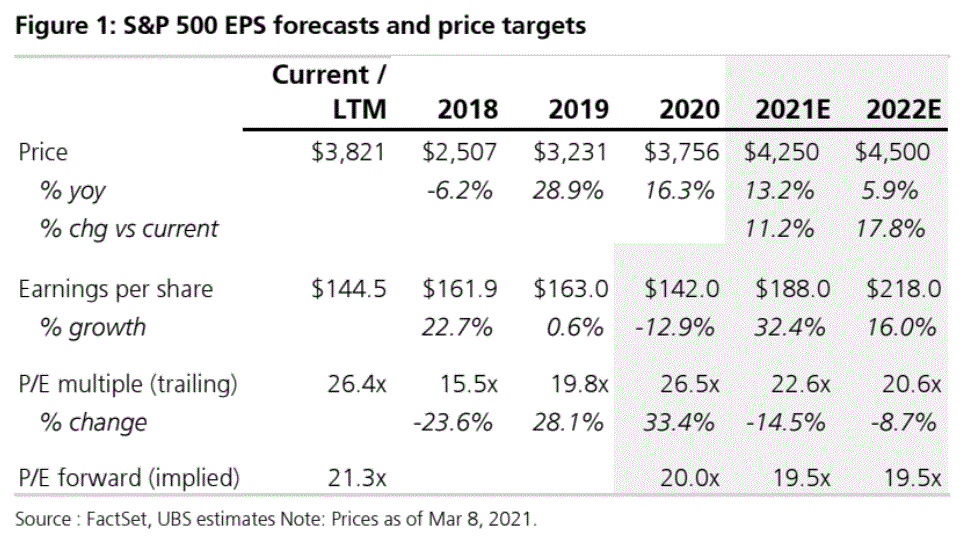UBS is getting on board with the MB profits boom thesis based upon tearaway US growth, strong fiscal support, a global inventory rebuild and top-line growth landing on lean post-recession business:
Revising S&P 500 target to 4250 on strengthening earnings expansion
As equities de-rate amidst the jump in rates, much better than expected earnings should drive further S&P 500 upside through 2021. We raise our S&P 500 price target for year-end to 4250, from 4100, on higher forecasted EPS of $188 for 2021 and $218 for 2022. Our ~$10 upgrade stems from greater stimulus, an acceleration in consumer spending and even stronger Q4 EPS than we expected. EPS of $218 is just a 10% CAGR from ’19to ’22e with ~$5tr of stimulus (thus far). Our target assumes a forward P/E of 19.5x, which is about 2x below the current level as rates rise, earnings go well above trend and taxes are increased. The S&P 500 forward P/E was ~18.5x in Dec ’19 when the 10y yield was nearly 2% and real yields were +15bp. Thus, we still see risks tilted to the upside.
Reassessing the risks: growth asymmetry vs. rates to the upside, tax/reg key
This time is different. With such unprecedented cross-currents, we use our frameworks to quantify the potential upside and downside impacts, relative to our baseline, for various catalysts and drivers. We see the upside case of even stronger consumption(+5%), pricing power (+6%) and higher 3-5yr growth expectations (+10%), offset by even higher rates (-6%) and less liquidity (-4%) as still pointing to net >10% incremental returns. The political stance is key with even higher cap gains and corp taxes as well as greater regulation a total -12% type overhang in our estimate.
Earnings themes: large and broad upgrades ahead
History would support our view of a very strong earnings recovery as S&P earnings have rebounded to 10%+ above trend levels in just 2 years for 5 of the last 8 cycles, without massive stimulus. With earnings the key driver for equities going forward, we assess the key themes and factors that point to continued large profit upgrades ahead.
– Low bar for H1, Q1 to beat by 10%+.S&P 500 consensus estimates for Q1 and Q2EPS barely budged despite the 12%+ beat in Q4. Assuming Q1 EPS is in line with Q4, it would imply 7% upside. Our model points to Q1 EPS of nearly $45, or a 14%+ beat. Importantly, weak performance on beats has not lasted for 2 consecutive quarters, so better earnings should get rewarded through Q1 reporting, unlike in Q4.
– Mgmt sentiment “neutral”, upside to cycle peaks.UBS Evidence Lab “EarningsCall Analyzer” tracks language on earnings calls. Mgmt net sentiment for the S&P 500has risen back to neutral, but is well below cycle highs. Changes in net sentiment tend to lead EPS revisions. Recent+further improvement points to continued profit upgrades.
– Re-opening EPS upside far exceeds stay at home downside. Forward earnings are35% below trend levels for the top 33% vaccine sensitive stocks (Airlines, etc), -20%below for the middle third and just 4.5% above trend for the relative winners.
– Operating leverage is underestimated. As demand recovers, costs typically lag and productivity improves. We see scope for margins to exceed prior peaks sooner than consensus expects. Industries with better through cycle sales have low margin forecasts.
-Pricing power rising. Our proprietary S&P pricing measure is <50% through a typical cycle. Further improvement would support margins, with risks to the upside.
– FCF jumped, payouts to follow. S&P 500 ex Financial FCF rose ~10% y/y in Q4, suggesting there is room to ramp up buybacks (+$200bn or 50%) and dividends.


